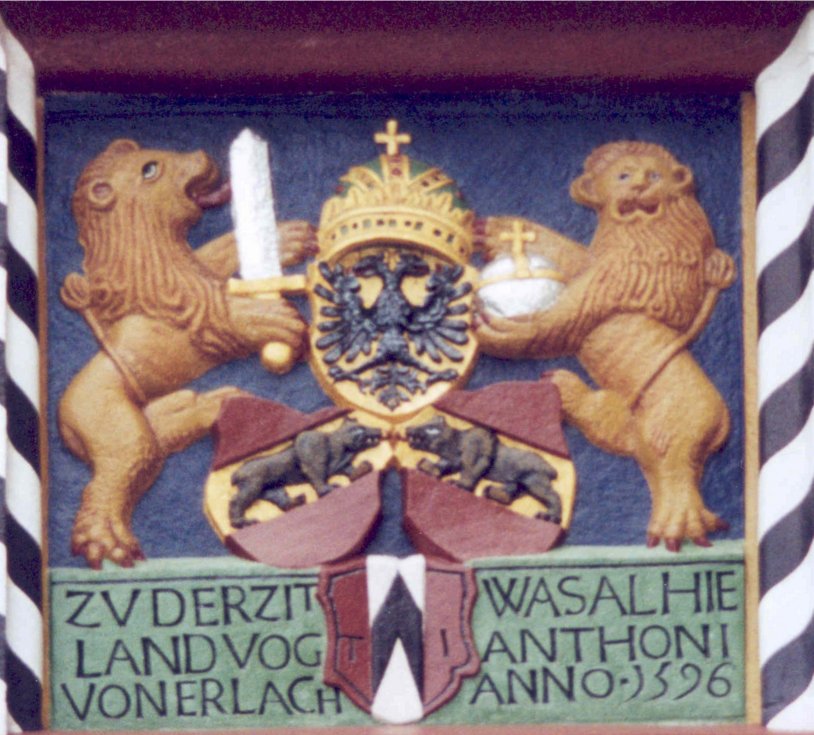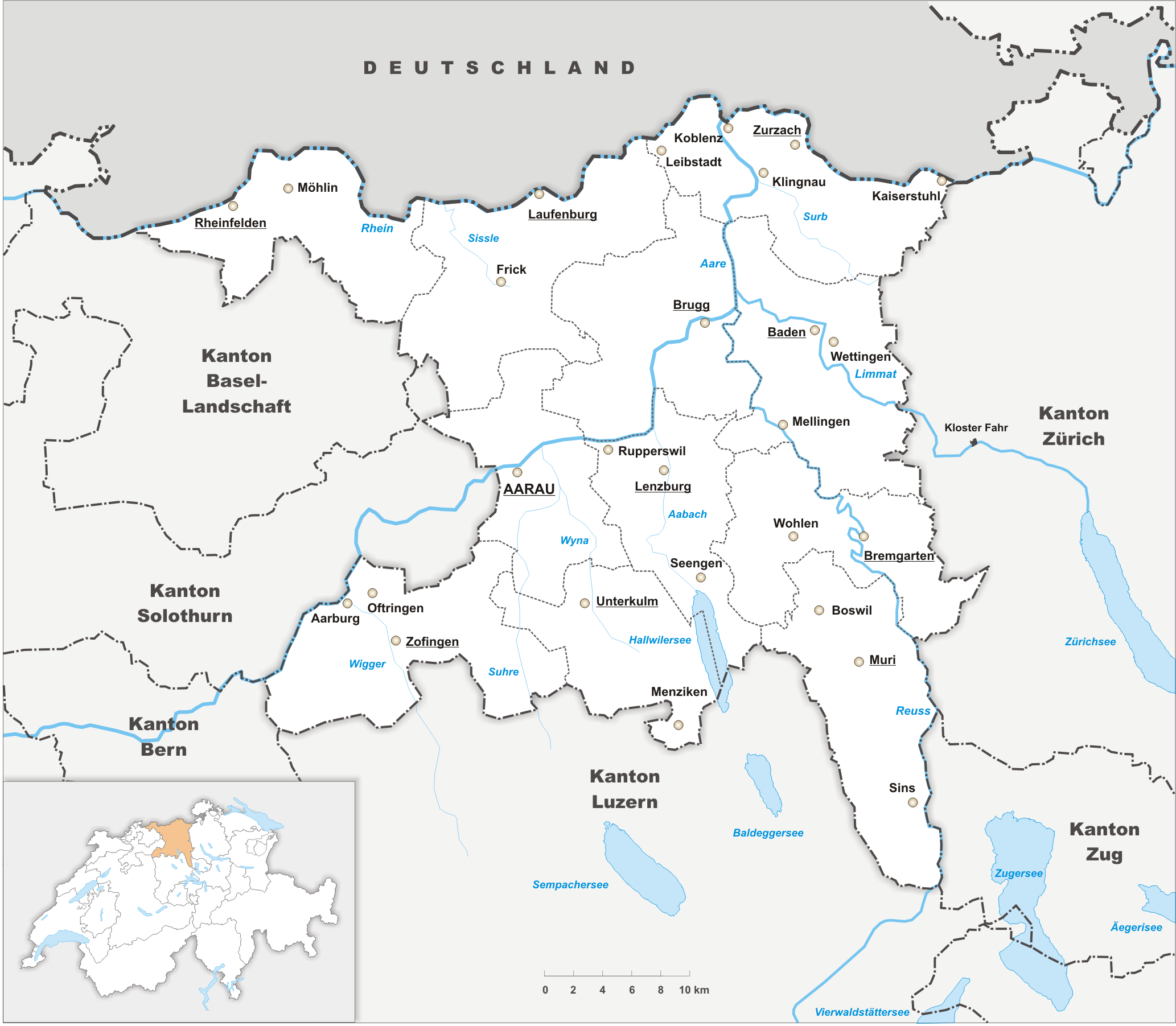|
Müllerhaus Lenzburg
The Müllerhaus is a listed townhouse in Lenzburg, Aargau, Switzerland. The early classicist building, which was commissioned by the Lenzburg cotton industrialist and built in 1785 by the Bernese architect Carl Ahasver von Sinner, is considered one of the most important cultural assets in Lenzburg. History The townhouse was built in 1785 during the cotton boom era and served as a residence and commercial building at the same time. The basement served as a warehouse, the first floor for sales, while the two upper floors were used as manorial apartments. After the economic decline of the Hünerwadel dynasty at the end of the 19th century, the doctor Adolf Müller-Fischer bought the vacant town house in 1903. He opened his medical practice there and moved with his family to the second floor. Since 1987, the architectural monument is owned by the cultural and charitable Foundation of Dr. Hans Müller (1897–1989) and Gertrude Müller (1901–2001), siblings and heirs of A. Müller ... [...More Info...] [...Related Items...] OR: [Wikipedia] [Google] [Baidu] |
Classicism
Classicism, in the arts, refers generally to a high regard for a classical period, classical antiquity in the Western tradition, as setting standards for taste which the classicists seek to emulate. In its purest form, classicism is an aesthetic attitude dependent on principles based in the culture, art and literature of ancient Greece and Ancient Rome, Rome, with the emphasis on form, simplicity, proportion, clarity of structure, perfection and restrained emotion, as well as explicit appeal to the intellect. The art of classicism typically seeks to be formal and restrained: of the ''Discobolus'' Sir Kenneth Clark observed, "if we object to his restraint and compression we are simply objecting to the classicism of classic art. A violent emphasis or a sudden acceleration of rhythmic movement would have destroyed those qualities of balance and completeness through which it retained until the present century its position of authority in the restricted repertoire of visual images. ... [...More Info...] [...Related Items...] OR: [Wikipedia] [Google] [Baidu] |
Lenzburg
Lenzburg is a town in the central region of the Switzerland, Swiss canton of Aargau and is the capital of the Lenzburg District. The town, founded in the Middle Ages, lies in the Seetal, Seetal valley, about 3 kilometres south of the Aare river. Lenzburg and the neighbouring municipalities of Niederlenz and Staufen, Switzerland, Staufen have grown together in an agglomeration. History A Neolithic grave field of the Cortaillod culture has been discovered on the ''Goffersberg'' (close to the Lenzburg Castle) dating from 4300 - 3500 BCE. A Roman theatre (structure), Roman theater was uncovered when a motorway was built in 1964. It was part of a small settlement with 500 inhabitants that existed for approximately 200 years. The settlement was abandoned in the 3rd century. In the 5th and 6th centuries, an Alamanni settlement existed. Lenzburg is first mentioned in 924 as ''de Lencis''. In 1036, Lenzburg Castle was used for the first time as seat for the Count of Lenzburg, then an impo ... [...More Info...] [...Related Items...] OR: [Wikipedia] [Google] [Baidu] |
Aargau
Aargau ( ; ), more formally the Canton of Aargau (; ; ; ), is one of the Canton of Switzerland, 26 cantons forming the Switzerland, Swiss Confederation. It is composed of eleven districts and its capital is Aarau. Aargau is one of the most northerly cantons of Switzerland, by the lower course of the Aare River, which is why it is called ''Aar-Gau (country subdivision), gau'' ("Aare province"). It is one of the most densely populated regions of Switzerland. History Early history The area of Aargau and the surrounding areas were controlled by the Helvetians, a tribe of Celts, as far back as 200 BC. It was eventually occupied by the Roman Empire, Romans and then by the 6th century, the Franks. The Romans built a major settlement called Vindonissa, near the present location of Brugg. Medieval Aargau The reconstructed Old High German name of Aargau is ''Argowe'', first unambiguously attested (in the spelling ''Argue'') in 795. The term described a territory only loosely eq ... [...More Info...] [...Related Items...] OR: [Wikipedia] [Google] [Baidu] |
Switzerland
Switzerland, officially the Swiss Confederation, is a landlocked country located in west-central Europe. It is bordered by Italy to the south, France to the west, Germany to the north, and Austria and Liechtenstein to the east. Switzerland is geographically divided among the Swiss Plateau, the Swiss Alps, Alps and the Jura Mountains, Jura; the Alps occupy the greater part of the territory, whereas most of the country's Demographics of Switzerland, 9 million people are concentrated on the plateau, which hosts List of cities in Switzerland, its largest cities and economic centres, including Zurich, Geneva, and Lausanne. Switzerland is a federal republic composed of Cantons of Switzerland, 26 cantons, with federal authorities based in Bern. It has four main linguistic and cultural regions: German, French, Italian and Romansh language, Romansh. Although most Swiss are German-speaking, national identity is fairly cohesive, being rooted in a common historical background, shared ... [...More Info...] [...Related Items...] OR: [Wikipedia] [Google] [Baidu] |
Carl Ahasver Von Sinner
Carl Ahasver von Sinner (February 2, 1754 – April 25, 1821) was a Canton of Bern, Bernese architect of the Louis XVI style, Louis XVI period. Biography Born in Sumiswald as the son of governor (''Landvogt'') Johann Bernhard von Sinner, he married Maria Susanna Zeerleder in 1780. He was a member of the Grand Council of Bern, in 1795 and head magistrate (''Oberamtmann'') of Schwarzenburg from 1803 to 1805. As an architect, he is noted for the palace of Landsitz Lohn, Lohn, now the country estate of the Swiss Federal Council; the Kleehof in Kirchberg, Bern, Kirchberg and the estate of Hofwil in Münchenbuchsee. Buildings * Landsitz Lohn, Kehrsatz, 1782–1783 * :de:Campagne Kleehof, Tschiffeligut (Kleehof), Kirchberg, Bern, reconstruction 1783 * Clergy house, Ammerswil, 1783 * Amtshaus (official residence), Aarau, 1784–1787 * Hofwil, Münchenbuchsee, 1784–1786 * :de:Schloss Rued, Schloss Rued, Schlossrued 1792–1796 * :de:Campagne Ortbühl, Ortbühl, Steffisburg, 1794 * Ga ... [...More Info...] [...Related Items...] OR: [Wikipedia] [Google] [Baidu] |
Aargauer Literaturhaus
The Aargauer Literaturhaus () is a cultural institution in Lenzburg (Aargau, Canton of Aargau, Switzerland) dedicated to the popularization of literature and literary practices. It carries out author talks, reading conferences, and literary workshops for all ages on a regular basis. Established in 2004, it is located in the city's cultural center, the Müllerhaus Lenzburg, Müllerhaus, an architectural monument of the 18th century and one of the most important . The House maintains a one-person writer's residence (with the right to stay up to three months) – the Atelier Müllerhaus studio. History The Müllerhaus, a three-story early classical mansion at 7 Bleicherain, "the most beautiful house in Aargau" half a kilometer from the Lenzburg Castle hill, was commissioned by the Lenzburg cotton industrialist and built in 1785 by the Bernese architect Carl Ahasver von Sinner. After the economic decline of the Hünerwadel dynasty at the end of the 19th century, the doctor Adolf ... [...More Info...] [...Related Items...] OR: [Wikipedia] [Google] [Baidu] |
Aargauer Zeitung
''Aargauer Zeitung'' (English: ''Aargauer Newspaper'') is a Swiss German-language daily newspaper, published by AZ Medien Gruppe, Aarau, Aargau. History and operations ''Aagauer Zeitung'' was created in 1996 through the merger of the '' Aargauer Tagblatt'' and '' Badener Tagblatt'' newspapers. The paper is edited in Aarau and Baden, Aargau. It produces several local editions, including under the titles ''Zofinger Tagblatt'' and ''Limmattaler Tagblatt''. Since January 2002, '' Mittelland Zeitung'' has been the common, core section of the newspaper as well as for newspapers '' Oltner Tagblatt'' and '' Solothurner Zeitung'' with a circulation of 200,000. . In 1997 ''Aargauer Zeitung'' had a circulation of 118,578 copies. See also * List of newspapers in Switzerland The number of newspapers in Switzerland was 406 before World War I. It reduced to 257 in 1995 and 197 in 2010. Prior to the 18th century, the Swiss press market was small, being limited to the elites who were ... [...More Info...] [...Related Items...] OR: [Wikipedia] [Google] [Baidu] |
Buildings And Structures Completed In 1785
A building or edifice is an enclosed structure with a roof, walls and windows, usually standing permanently in one place, such as a house or factory. Buildings come in a variety of sizes, shapes, and functions, and have been adapted throughout history for numerous factors, from building materials available, to weather conditions, land prices, ground conditions, specific uses, prestige, and aesthetic reasons. To better understand the concept, see ''Nonbuilding structure'' for contrast. Buildings serve several societal needs – occupancy, primarily as shelter from weather, security, living space, privacy, to store belongings, and to comfortably live and work. A building as a shelter represents a physical separation of the human habitat (a place of comfort and safety) from the ''outside'' (a place that may be harsh and harmful at times). buildings have been objects or canvasses of much artistic expression. In recent years, interest in sustainable planning and building practi ... [...More Info...] [...Related Items...] OR: [Wikipedia] [Google] [Baidu] |
Neoclassical Architecture In Switzerland
Neoclassical or neo-classical may refer to: * Neoclassicism or New Classicism, any of a number of movements in the fine arts, literature, theatre, music, language, and architecture beginning in the 17th century ** Neoclassical architecture, an architectural style of the 18th and 19th centuries ** Neoclassical sculpture, a sculptural style of the 18th and 19th centuries ** New Classical architecture, an overarching movement of contemporary classical architecture in the 21st century ** in linguistics, a word that is a recent construction from Neo-Latin based on older, classical elements * Neoclassical ballet, a ballet style which uses traditional ballet vocabulary, but is generally more expansive than the classical structure allowed * The "Neo-classical period" of painter Pablo Picasso immediately following World War I * Neoclassical economics, a general approach in economics focusing on the determination of prices, outputs, and income distributions in markets through supply and dema ... [...More Info...] [...Related Items...] OR: [Wikipedia] [Google] [Baidu] |




